Are you the user or the product? The tale of Parents Night Out vs. Kids Night Out.
You might have heard the phrase “If you are not paying for the product, you are the product” as a way to describe tech consumer companies where their business model is advertising. It’s a very limited — and wrong — way to explain the relationship between businesses, who they serve and who pays for it.
As much as we believe tech entrepreneurs are trail blazing new paths, mostly we are just mimicking paths previously traveled by other industries. My own business matches the description I stated above. The buyer is employers, but the user is the employee (a.k.a., a person). So who are we serving? Employers or employees?
When a parent goes to the supermarket and buy yogurt for their kids, there are two customers being served. The parent who is paying for it, and the child who will actually use (eat) the product. So who is the primary customer? The parent or the child? The answer is pretty obvious to me. It’s the child. If you can’t satisfy their demands/needs the buyer (parent) won’t buy it. They might even buy it once, but it won’t be a repeat buy (no retention).
From the parent (buyer) perspective, the question they are asking is not “is this the best?” or “is this the one I want?” — Even though they are asking those questions out loud, but not necessarily using it to make their purchase decision — they are implicitly focused on “is this safe enough to try?” If parents think a brand of yogurt is “safe to try” (based on whatever parameters are important to them) and kids like that yogurt (it serves the customers’ needs), you have a winning combo. Now you need to create awareness and generate demand, and that’s another topic.
Which brings me to the tale of two elementary schools I’ve been exposed too. Both of them have this “product” in which they will babysit kids so parents can have the night out for a few hours. They both provide activities to kids while they are there, they both have about the same quality of service, but one school gets who is the customer and the other doesn’t. That clearly shows on the number of participants in those programs. By focusing on the interested customers (the kids) and making it safe (for parents), one of the schools made a better product and it’s clearly more successful.
The bottom line is that you should focus on the user of the product first and foremost, and make it safe enough for the buyer. If you are making product decisions to benefit the buyer in detriment of the user you’ll lose because either the buyer won’t buy or they won’t renew. Obviously, it’s better when you deliver win-win to buyers and end-users, but if it’s not possible, stick with the end-users. You might lose business over the short term, but it’s the only way to create a sustainable business.
